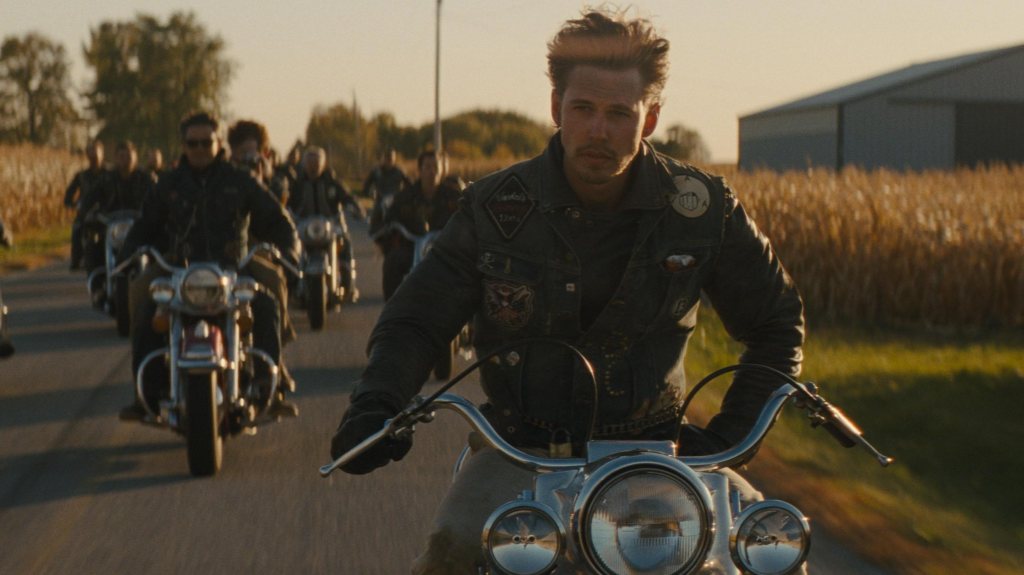The gang revs up to go idling through the heartland
By Tom Meek


In the latest from Jeff Nichols, a dying way of life receives a nostalgic elegy. Beyond the big gleaming chrome growl of the Harley hog, “The Bikeriders” is something of a kindred spirit to the 1983 Francis Ford Coppola adaptations of the S.E. Hinton novels “Rumble Fish” and “The Outsiders.” Like those gritty, spare portraits of Midwestern isolationism, “The Bikeriders” embeds us with a tribe who exist on the fringe of society and abide by their own laws. In this case it’s a fictional bike gang named the Vandals that operates on the outskirts of Chicago in the late 1950s and 1960s. The film depicts the chopper brigade as more misunderstood than hood at first, but there’s a shift from freedom of expression (“Easy Rider”) to the more criminal (“Sons of Anarchy”) as new blood infuses the ranks.
Inspired by Danny Lyon’s 1968 similarly titled photo collection – making it like Larry Clark’s provocative “Tulsa,” which was a film and book of photographs – “The Bikeriders” flexes epic aspirations early on while centering on the bromance between gang leader Johnny (Tom Hardy) and his mercurial sergeant-at-arms Benny (“Elvis” himself, Austin Butler) with Benny’s (initially) reluctant love interest Kathy (Jodie Comer, “Killing Eve”) regularly at odds with Johnny in a battle for the man’s soul, if you will.
Lyon is a character in the film, played by Mike Faist (“Westside Story,” “Challengers”), who hangs occasionally with the Vandals and shoots them while carousing at their biker bar hangouts or drunken campground jamborees. Much of the film’s narrative is meted through his tape-recorded interviews with Kathy over the years as she recounts the rise and fall of the Johnny-led Vandals. It’s a neat device that allows the film to be agile in its temporal movements; the downside is that it saps the grit and grimness of the road and the gang. Imagine if Lorraine Bracco’s Karen Hill narrated “Goodfellas” (1990).
Nichols’ films – “Mud” (2013) and “Take Shelter” (2011) to name two – have generally been about discovery in the heartland. He stretches here. There are moments that punch and pull and others that feel like they are leading somewhere new yet never quite arrive. One of the film’s minor missteps is in Benny, a lone wolf and a romantic, as the film avers through the eyes of the deeply invested Johnny and Kathy. But the character we are given never feels as compelling as we are told. We buy it because of Butler’s ingrained natural charisma and his haunting splash of Johnny Depp’s “Cry-Baby” (1990) simmer.
Hardy (“The Dark Knight Rises,” “Mad Max: Fury Road”), a thinking man’s thug if ever there was one, does much of the heavy lifting as a man who relishes the power of his post but knows there’s a target on his back from the Vandal code, which says members can challenge him to fight to settle a disagreement or move up in rank. What Hardy renders onscreen feels pulled from Brando in “The Wild One” (1953) with a bit of a Boston accent poured on.
The cast of old-school riders is an eclectic mix that features Michael Shanon and Joel Edgerton, who have worked with Nichols before individually (“Take Shelter” and “Loving,” respectively) and collectively (“Midnight Special”), as well as Norman Reedus, who’s a natural on a hog (he did have his own motorcycle travelogue show on AMC); Emory Cohen, the crew’s lovable Squiggy, who goes by the moniker Cockroach because he likes to eat bugs; and Toby Wallace, who plays Sex Pistol guitarist Steve Jones in the Danny Boyle series “Pistol” and kindles more of that menacing youthful sneer here as The Kid, an ambitious punk who wants admittance to the Vandals but runs afoul of Johnny. It’s a Shakespearean kick that needed more revving for its payoff.
Shot by longtime Nichols collaborator Adam Stone, “The Bikeriders” looks the part, capturing the grungy, neon-lit shanty bars and vast farmlands in the day’s dying light. The performers are all in character too, yet the grind of the gangland network gets occasionally sidetracked and lost is in the melodrama of minutiae.


